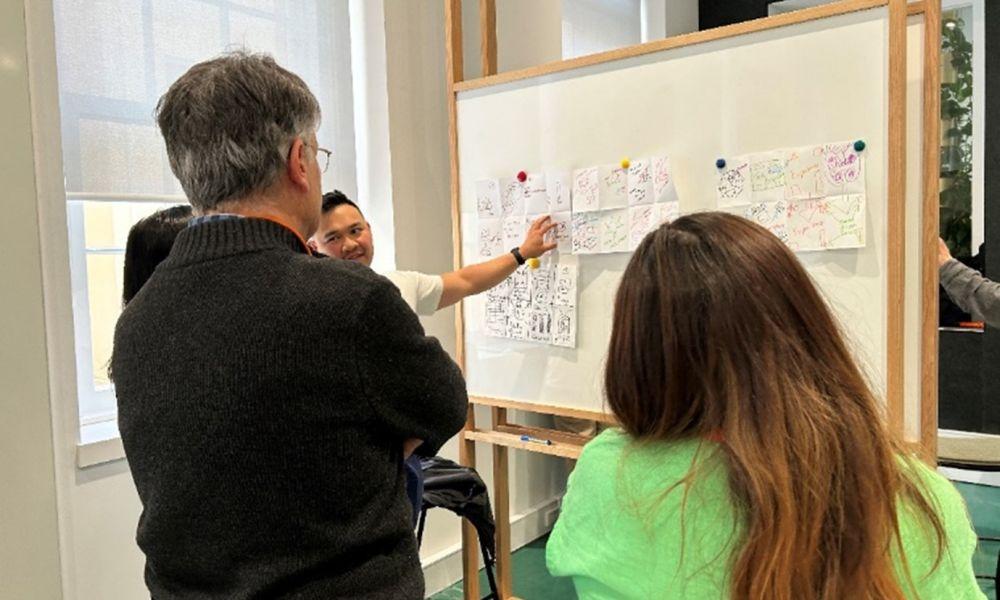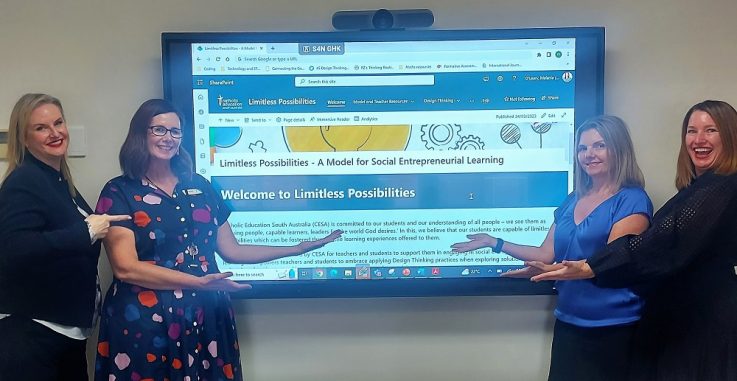Design thinking is not just an educational buzzword having its moment in history; it is a transformative approach that equips students with the skills and mindset needed to solve complex, interdisciplinary problems.
As a Master Teacher in Residence for Technologies at the Victorian Academy of Teacher and Leadership, I’ve been fortunate to work with STEM and Technologies teachers from across the state. In my experience, many have not engaged with design thinking in any capacity, due to a lack of easily accessible and clear information geared towards classroom teachers, both on the process, and its interdisciplinary applications.
Understanding design thinking
As captured by Tim Brown (2009), design thinking is not just a strategy; it is a journey to ‘inspire innovation’ and champion transformative change.
It is a problem-solving approach that focuses on human-centred solutions. It emphasises empathy, collaboration, and iteration to solve complex problems in innovative ways. The design thinking process is iterative rather than linear, meaning that designers might loop back to earlier stages as they gather more information and refine their solutions. (Razzouk & Shute, 2012). The core revolves around the user – understanding their needs, desires, and challenges.
The process can be succinctly described through the 5 stages put forth by the Hasso-Plattner Institute of Design at Stanford (d.school, n.d.).
- Empathise: Dive deep into understanding the user's needs and experiences.
- Define: Articulate the problem that needs addressing.
- Ideate: Engage in a brainstorming frenzy, unleashing creativity.
- Prototype: Create tangible or conceptual representations of solutions.
- Test: Trial and fine-tune the solutions.
Bringing design thinking to life in classrooms
Design thinking offers a fresh approach to teaching and learning, emphasising empathy, creativity, and continuous improvement. Given the ever-evolving challenges and dynamics of today's educational landscape, the strategies and mindsets derived from design thinking are invaluable assets for educators and students alike.
Ignite with empathy: As Kees Dorst (2011) compellingly argues, the crux of design thinking is recognising and addressing genuine user needs through a human-centred design approach. It is more than mere observation; it demands engagement. For example, if the task for your students is to design tools for farmers, a visit to local farms or interviews with farmers can provide invaluable insights, and hence becomes an essential part of your planning.
Champion big ideas: The classroom should pulsate with creativity, where no idea is too 'out there'. As Wagner (2012) elucidates, nurturing young minds to become innovators is paramount. This is where leaning into the general capability of critical and creative thinking comes into play, with educators being able to lean into the design thinking model to create those opportunities for creative thinking and play in a structured environment.
The power of prototyping: As Scheer, Noweski, & Meinel (2012) aptly express, it is essential to transform abstract ideas into tangible action. Whether it is crafting a rudimentary model using craft supplies or employing digital tools for a simulation, prototyping crystallises ideas.
Iterate with community feedback: Design thinking thrives on feedback. Involving the wider Australian community, from Aboriginal and/or Torres Strait Islander elders to urban planners, can provide varied perspectives that refine student prototypes. Through prototyping and testing, students come to understand that their initial ideas may need refinement. This iterative approach teaches them to embrace change and persevere when faced with setbacks.
Learning across disciplines: Design thinking does not belong to any one discipline. It can be used across the curriculum. This comprehensive approach promotes interdisciplinary learning, teaching students to see connections across different areas of knowledge. The answer lies in its adaptability and potential for cross-curricular integration. Let us explore this through 2 illustrative examples:
Problem statement 1: ‘Design a sustainable city for future generations.’
- Mathematics: Students engage in calculations concerning population projections, infrastructure budgets, and resource allocations.
- Science: Delving into sustainable energy, eco-friendly materials, and balancing ecosystems introduces a scientific perspective.
- Social Studies: Here, the focus shifts to migration patterns, governance models, and historical examples of city planning.
- Arts: Visualisation is crucial. Students can create models, sketches, and digital designs to bring their city to life.
Problem Statement 2: ‘How can communities develop sustainable farming practices in changing climate conditions?’
- Biology: Understand plant species, growth conditions, and the impact of pests and diseases.
- Economics: Analyse the market demand for crops, pricing strategies, and the economic viability of organic farming.
- Environmental Science: Explore soil conservation, water management, and organic farming's ecological benefits.
- Civics and Citizenship: Dive into policies supporting sustainable agriculture and the role of community cooperatives.
Myths – what design thinking isn’t
Design thinking’s exponential rise in popularity across various sectors and industries as a problem-solving approach, has also led to some misconceptions emerging:
It's only about design: Because of the term ‘design’, some believe design thinking is only relevant for designers or is solely about aesthetics. In reality, design thinking is a problem-solving framework that can be applied in various fields beyond design, from business strategy to education and healthcare.
It's just brainstorming: Some reduce design thinking to just its ideation phase. While brainstorming is an essential part of the process, design thinking encompasses much more, from understanding user needs to prototyping and testing.
It always leads to innovation: While design thinking can foster innovative solutions, it does not guarantee innovation. The process is about finding the right solution for the problem, which might sometimes be a simple or previously known solution.
Anyone can do it without guidance: Just because the principles of design thinking are widely accessible, does not mean everyone can apply them effectively without guidance or experience. Proper training and practice can help in harnessing the full potential of the approach. Design thinking is a sophisticated tool that reaches its full potential when enacted appropriately.
It's a trend or fad: While design thinking has gained significant attention in recent years, it is rooted in practices that have been developed over decades, such as ‘agile’ and ‘lean’ methodologies, and implemented by design behemoths like Apple and Boeing. It is a tested approach that will continue to be relevant for problem-solving across all disciplines and industries.
Ripple effects beyond the classroom
When classrooms become hotbeds of inquiry and innovation, the implications are profound. Students emerge as:
- Empathetic observers – they learn to listen, observe, and understand, forming the foundation of empathy.
- Critical thinkers – Questioning the status quo becomes second nature. They evaluate, analyse, and synthesise information from multiple sources.
- Collaborative problem solvers – Design thinking thrives via meaningful teamwork opportunities. Students collaborate across interests, personal strengths, and subjects, extracting share insights and crafting holistic solutions.
When design thinking is authentically integrated into our teaching practices, classrooms become crucibles where real-world challenges meet innovative solutions, all woven through a rich tapestry of subjects. And as students navigate this journey, they are not just learning; they are preparing to shape the world of tomorrow.
Anam Javed is a Master Teacher in Residence at the Victorian Academy of Teaching and Leadership. The picture accompanying this article was taken at the Victorian Academy of Teaching and Leadership Design Thinking Space.
Related reading: Teacher Awards 2023: Curriculum Design and Implementation
References
Brown, T. (2009). Change by design: How design thinking transforms organisations and inspires innovation. Harper Business.
Razzouk, R., & Shute, V. (2012). What is design thinking and why is it important? Review of Educational Research, 82(3), 330-348. https://doi.org/10.3102/0034654312457429
Hasso-Plattner Institute of Design at Stanford (d.school). (n.d.). An Introduction to Design Thinking PROCESS GUIDE.
Dorst, K. (2011). The core of ‘design thinking’ and its application. Design Studies, 32(6), 521-532.
Wagner, T. (2012). Creating innovators: The making of young people who will change the world. Scribner.
Scheer, A., Noweski, C., & Meinel, C. (2012). Transforming constructivist learning into action: Design thinking in education. Design and Technology Education, 17(3), 8-19.
Are you using design thinking in your own curriculum planning? If not, what are some of the barriers to you using it? Do you have any worries or misconceptions? What resources and professional support would you need to introduce design thinking into your own school?



